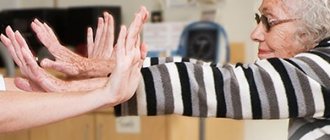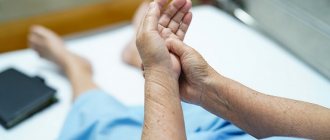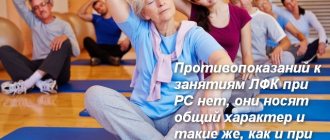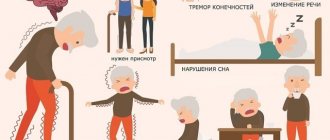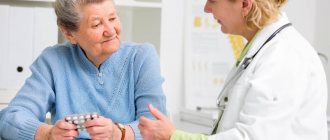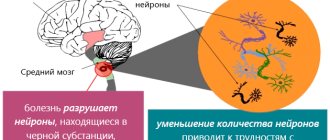Parkinson's disease is a severe brain pathology associated with a disorder in the metabolism of dopamine, which regulates the conduction of nerve impulses. With its deficiency, motor activity suffers: muscle tone increases, they begin to contract slowly and with difficulty, and the person is not able to move at the usual pace. In such situations, drug therapy for Parkinson's disease is supplemented with physical therapy for all muscle groups.
Features of the treatment of Parkinson's disease with physical exercises
Against the background of constant muscle tension, a patient with parkinsonian disorders changes his posture, his gait becomes shuffling, his movements are slow, tremors in the limbs and balance problems appear. In the final stages of the disease, the patient becomes completely immobilized due to impaired functional activity of the muscles.
Treatment of patients with parkinsonism includes drugs based on levodopa, which replenish dopamine deficiency, as well as elements of physical and breathing exercises, exercise therapy in combination with medications act as follows:
- Reduces tone in tense muscles (this also reduces trembling);
- Restore mobility in the cervical, thoracic and lumbar spine;
- Regulate coordination of movements;
- Normalize motor skills and gait;
- Increased thoracic kyphosis is leveled;
- Increase range of movements;
- Improves mood and general condition.
results
During the study, it was found that patients in group 1 were younger compared to patients in group 2 (see table).
Data from the anamnesis and medical examination of patients of the 1st (1) and 2nd (2) groups Note. * — p<0.05. The duration of PD was longer in patients with a sports history. From the 1st group, 3 patients denied the presence of a comorbid disease - hypertension, although one of them had an increased blood pressure level during an objective examination. The remaining patients, both with and without a sports history, noted the presence of A.G. The maximum values of elevated SBP and DBP, recorded at least once in the patient’s life at a doctor’s appointment or during self-measurement of blood pressure, did not differ between the patients of the two groups. It should be taken into account that patients with elevated blood pressure were on constant antihypertensive therapy, taking from 1 to 4 drugs, and the number of drugs to correct high blood pressure did not differ.
The average BMI values in the groups corresponded to excess body weight, i.e., they ranged from 25 to 29.9 kg/m2, and did not differ among the groups. Dynamometry indices of the right and left hand were higher in patients with PD and a sports history. The average values of SBP and DBP in the supine and sitting positions did not differ among the groups and corresponded to normal (SBP=120-129 mmHg, DBP=80-85 mmHg) or optimal values (SBP<120 mmHg. Art. and DBP<80 mm Hg). However, the difference in mean DBP values during the transition from a supine to a sitting position differed between groups due to an increase in DBP in group 1 athletes and a decrease in DBP in group 2 patients.
The total score characterizing the severity of motor impairment on the MDS UPDRS scale (Part III) did not differ in patients of both groups (23.33±6.26 versus 21.00±8.80; p
>0.05).
But the hypokinetic syndrome was more pronounced in patients of group 1 - former athletes (in 6 people bradykinesia was rated at 3 points, in 4 - at 4 points). Among patients with PD who did not engage in sports, only 2 people received a score of 3 points and 1 - 4 points (χ2=7.35; df=1; p
<0.05).
A set of exercises useful for Parkinson's disease
Each lesson should last at least 10 minutes and include the following elements:
- Power loads;
- Stretching tasks;
- Dynamic joint training;
- Mimic gymnastics;
- Breathing techniques.
Note!
The number of classes per day is determined individually by the physical therapy doctor and depends on the severity of the patient’s condition and the form of the disease.
It is recommended to do an average of 10-12 approaches.
Exercises to improve posture
- In a sitting position, we try to straighten our back as much as possible, resting our palms on the lumbosacral region.
- Still sitting, place your feet shoulder-width apart and place your palms on your waist. We lean back and forth. You can complete the task while holding the back of a chair.
- From a similar position, we tilt the body left and right.
- Lean against the wall so that only the occipital protuberance, shoulder blades, sacrum and heel bone are in contact with it. Press firmly with the interscapular area on the vertical surface.
Abdominal exercises
- Stretch out on the floor with your arms outstretched at right angles to your torso, palms up. Twist your body to the right, covering your left palm with your right, and vice versa.
- Lie on your back, pull your feet towards your buttocks. Raise your upper torso towards your hips. You can help yourself with your hands, hugging your knees with them and pulling your body forward.
- Lie flat, arms at your sides, feet facing you. Raise your head and shoulders, trying to see your toes.
- If possible, pump your abs in the classic way, with your hands behind the back of your head. In this case, an assistant can fix your legs in the area of the knees and shins.
Exercises for the neck and shoulder muscles
- We consistently bow our heads to one shoulder girdle and to the opposite one.
- We tilt the head to the chest and throw it back to improve mobility in the cervical vertebrae.
- We slowly turn our heads in one direction or the other, trying to examine the surface of the shoulder blades. In this case, there is no need to rush, so as not to provoke dizziness.
- We smoothly make circular movements with our heads, first pressing the chin to the chest, then the ear to the shoulder, the back of the head to the spine, the second ear to the shoulder girdle and back.
Exercises for the muscles of the shoulder girdle
- As you exhale, raise your shoulders up, and as you inhale, lower them. Significant tension in the muscles of the upper shoulder girdle should be felt.
- We place the fingertips on the shoulder joints and carry out rotational movements in them alternately anteriorly and posteriorly.
- We place our arms perpendicular to the body, bend them at the elbows, bringing our hands to the front surface of the shoulder joints. As you inhale, we try to connect the shoulder blades as much as possible; as you exhale, you should relax and take the starting position.
- Take a gymnastic stick in your hands, extend it in front of you parallel to the floor and pretend that you are working with an oar while rowing with one or the other hand.
Hand exercises
- We approach the wall at the length of an outstretched arm, rest our palms on it and smoothly lean forward, shifting our body weight onto our hands. We do not stick out our buttocks. Then we push off the wall with our hands and straighten up.
- We sit down at the table, placing our forearms on the tabletop with our palms down. We rhythmically turn the hands, either palmally or with the back surface up, moving faster and faster.
- We clench our fingers into fists and rotate our wrists, first inward, then outward.
- We take turns connecting the pads of our thumbs with all the others, gradually increasing the pace.
Exercises for the muscles of the lower limbs
- Lie down on the floor. Bend your left knee without lifting your sole off the floor. Place your right hand on your knee joint and pull it to the right for 10 seconds. Repeat with the other leg.
- Turn over face down, resting on your forearms. Bend your legs alternately at the knee joints, trying to touch your heel to the buttock area.
- We sit on the floor, stretch our legs forward. Rotate your feet first inward, then outward.
- We squeeze and straighten our toes.
Exercises to improve knee movement
- Sitting on a stool or on the edge of the bed, we straighten and bend our legs at the knee joints in turn.
- In the starting position from the previous exercise, stretch out the right leg and place it on a low stool. Sliding our hands along the front surface of the leg, we stretch as far as possible, touching the foot if possible. We freeze in this position for 10 seconds and straighten up. Repeat with the left leg.
- Sit on the floor, stretching your legs and resting your straightened arms on the floor slightly behind your back. Bend your legs at the knee joints, pulling your feet towards your pelvis, and return to their original position.
- Lie down on a horizontal surface and do the classic version of the “bicycle” exercise, simulating pressing the pedals.
Tension and relaxation of the thigh and calf muscles
- Leaning on the back of a chair on one side, we lunge forward alternately with one and then the other leg. We try to get down as close to the floor as possible and hold in this position for 15-20 seconds.
- Still holding onto the chair, we first stand on our tiptoes, stretching the calf muscles, and then again on the full sole, relaxing.
- We perform regular or half squats at a support.
- We lie on our backs straight and alternately raise our straightened legs up as far as possible.
Exercise to improve posture
Target:
learn to regulate the tension of the muscles of the neck and torso in order to counteract the formation of a “bent posture”.
Stand with your back to the wall, so that the back of your head, shoulder blades, buttocks, thighs and shins touch the wall; arms are placed along the body, palms rest against the wall. Try to “squeeze” into the wall with tension (up to a count of 5), and then you should relax and rest as long as you need. Repeat the exercise several times, try not to interrupt your breathing. Starting position, as in the previous exercise. Remaining “stuck” to the wall with the back of your head, back, buttocks and palms, squat down “sliding” your back along the wall. If you find it difficult to get up afterwards, place a chair nearby or take a stick to lean on. Stand facing the wall so that one cheek is turned to the side, your chest and stomach, your hips seem to “stick” to the wall. Extend your arms at shoulder level and position them so that your palms “stick” to the wall. Raise your palms “sticking” to the wall up above your head. When your palms are above your head, exhale; when they return to shoulder level, inhale. Do the exercise until you feel pleasantly tired.
"Trso Twist"
Target:
improving the mobility of the muscles of the neck, shoulders, and torso. While sitting or standing, place your palms on your shoulders or behind your neck. Turn your head, neck and torso, first in one direction and then in the other, as much as possible. You should feel a slight tension in your torso muscles. Repeat 10 times.
Bending of the torso
Target:
improved posture and improved mobility in the thoracic and lumbar spine.
Sitting on a chair, place your palms on your knees, lean forward, then arch your back and straighten your shoulders. Then sit up straight. Repeat 10 times.
While sitting on a chair, place your hands on the lower back area (“grab yourself by the lower back”). Bend at the waist, sticking your chest forward and straightening your shoulders, counting to “20”. Then sit up straight. Repeat 10 times.
Abdominal exercise
Target:
strengthening the abdominal muscles.
Lying on your back (on the floor, on the bed), bend your knees, placing your feet on the floor (bed). Slowly extend your arms forward and sit down, raising your shoulders and head (while your lower back touches the floor) as many times as you have the strength to do without losing your breath. Touch your hands to your knees. Then return to the starting position. Repeat 10 times.
"Bridge"
Target:
strengthening the muscles of the trunk, thighs and training turns in bed. Lying on your back, bend your knees, placing your feet on the floor (bed), lift your pelvis, leaning on your feet and shoulders, turn left and right. Repeat 10 times.
Push ups
Target:
Stretching the shoulder muscles and improving posture. Stand facing the corner of the room. Place your hands on both walls and lean towards the corner, bending your elbows so that you feel the muscle tension. When bending, do not lift your feet off the floor. Bend over and continue to rest your hands on the walls, count to 20. Then return to the starting position. Repeat 10 times.
Circular movements and bending of the torso Purpose: to improve the mobility of the torso muscles. Starting position: standing, feet shoulder-width apart, hands at the waist. Perform circular movements with your torso (as if you were twirling a hoop), as well as bending forward, backward, and to the sides. Repeat 10 times in each direction. Exercises for the muscles of the neck and shoulder girdle Turning the head to the sides Goal: improving mobility in the cervical spine. While sitting or standing, slowly turn your head from side to side, trying to look behind your shoulder when turning. Turn your head and hold it in this position for a count of 5. You should feel a slight tension in your neck muscles. Repeat 10 times.
Head tilts to the sides
Target:
improved mobility in the cervical spine. In a sitting position. Slowly tilt your head to the sides, towards each shoulder in turn. While bending, try not to turn your head, look forward. With each bend, you should feel a slight tension (“stretch”) in the neck muscles. Perform 10 bends in each direction.
Head tilts forward and backward
Target:
improving posture and reducing the fixed flexion position of the head.
In a sitting or standing position. Bend your neck and push your chin forward.
Then return to the starting position. Repeat 10 times. Lower your head and touch your chin to your chest, return your head to its original position. Repeat 10 times. After this, slowly tilt your head back (if you perform this movement while standing, it is better to play it safe by holding on to a strong, stationary object or a bracket on the wall). Leaning your head back, try to relax your neck muscles and “feel this position.” It should counteract the fixed position of the neck in a flexed position.
Exercises for the muscles of the shoulder girdle
Exercise for alternately tensing and relaxing the muscles of the upper shoulder girdle (“prayer”)
Target:
achieve tension and relaxation of the muscles of the upper shoulder girdle by training.
While sitting or standing, bring your hands together with your palms facing each other.
Strain your arms as hard as you can so that your palms rest against each other. Count to "20". Then relax your arms and “throw” them down. Repeat 5-10 times. Try to record in your memory how you feel when you tense your arms and when you relax them. Try to reproduce the feeling of relaxation when stiffness increases. Shoulder extension (“straighten your shoulders”)
Target:
increased range of motion in the joints of the upper shoulder girdle. While sitting or standing, bend your elbows and move your elbows back, bringing your shoulder blades closer to each other. Hold them in this position for a count of five. Then relax and return your arms to the starting position. Repeat 10 times.
Circular movements in the shoulder joints
Goal: increasing the range of motion in the shoulder joints. While sitting or standing, make circular movements with your shoulders (the shoulder moves up, back, down and forward). Perform together or alternately with each shoulder 5 times. Then repeat circular movements in the opposite direction (down, forward, up, back).
Exercise with a stick
1) raising and lowering
Goal: increasing the range of motion in the shoulder joints. While sitting or standing, take a wooden stick (cane) about 1 meter long with both hands and lift it to chest level. Then try lifting the stick above your head. Next, lower your arms to chest level and then lower your hands to your knees.
Repeat 10 times.
Exercises for facial muscles
In Parkinson's disease, not only skeletal muscles suffer: facial muscles also become less mobile, “waxy”. With the help of a special complex of physical therapy, the patient is able to get rid of the mask-like, amicable face and again actively express emotions. To better control the correct execution, you should practice in front of a mirror.
- Alternately portray surprise, joy, and anger on your face. Hold each expression for 3-5 seconds.
- Consistently raise your brow ridges, frown, and close your eyes tightly.
- Stretch and purse your lips tightly, then open them slightly and say “cheese.”
- First, at a slow and then at the fastest pace, stretch your lips, and then pull them out with a tube.
- Inflate and deflate your cheeks.
- Stick out your tongue and move it alternately left and right, up and down.
- “Draw” circles with the tip of your tongue, first clockwise and then counterclockwise.
Perform each exercise at least 10 times.
Important information!
Tongue exercises are necessary to prevent swallowing disorders. These disorders occur in the later stages of the disease and cause serious complications in the respiratory tract when food gets into them.
Breathing exercises
The function of the respiratory muscles in Parkinson's disease also suffers: the depth and efficiency of inspiration decreases. This is also facilitated by changes in posture and the formation of stoop. To restore the normal biomechanism of inhalation and exhalation, the following exercises are recommended:
- Sit on a stool or the edge of the bed and place your palms on the front abdominal wall. Inhale deeply, feeling your stomach inflate. Exhale slowly through pursed lips.
- Go to the wall and press your back against it so that your spine touches it along its entire length: from the lower cervical region to the sacrum. As you inhale, extend your arms upward, also along the wall. As you exhale, cross them over your chest.
- As you inhale, stand on your tiptoes, raise your arms up and stretch, while exhaling, stand on your full foot, bend down so that your arms hang freely.
Each time you need to do 10 breathing movements.
Additional tips and tricks
When performing any exercise, you need to follow the rules to achieve the greatest effectiveness from your workout:
- You should exercise regularly, in accordance with the regimen prescribed by the doctor.
- It is advisable to start training after taking medications, when the symptoms of the disease are less pronounced, it becomes easier to move, and the patient’s physical activity increases.
- Before training, it is advisable to perform a light muscle massage to improve local blood flow and reduce spasm.
- You need to move slowly at first, then gradually increase the pace.
- Rhythm is very important, so it is better to practice with appropriate music or a loud score.
- You should not bring yourself to excessive fatigue. Normally, half an hour after finishing classes, your strength should be fully restored and your energy should appear.
- After completing the main gymnastic complex, time is allocated for breathing training.
Recommendations from experts!
In the early stages of Parkinson's disease, neurologists recommend not only classical exercise therapy, but also activities such as walking, skiing, swimming, cycling, playing volleyball, badminton, and golf. Patients should overcome a shuffling gait through regular long walks; through swimming, they should restore their usual posture; dynamic games help improve balance and posture.
Exercise therapy for Parkinson's disease is necessary primarily to maintain normal motor activity and the ability to move. With adequate drug therapy, physical activity slows down the progression of the process and makes the course of the disease easier, preventing the development of complications.
Useful tips
We deliberately do not offer you a ready-made set of exercises - let a rehabilitation specialist develop it for you, but we will share general recommendations:
- you need to practice every day;
- the amount of training depends on the instructions of the neurologist and methodologist; this is largely determined by the patient’s previous (before the illness) lifestyle;
- overload should not be allowed, the best option is a slight feeling of fatigue, which is replaced by cheerfulness;
- exercises should be aimed at all muscle groups, but more attention should be paid to restoring motor ability;
- It is very important to maintain rhythm when performing exercises;
- It is advisable to choose the right time for training - if the patient feels weak in the morning and is active in the afternoon, then he should train after lunch.
Persistence and determination will allow the patient to cope with these difficulties and slow down the progression of Parkinson's disease. This is an opportunity to improve the quality of life, soften the blow dealt by fate!

